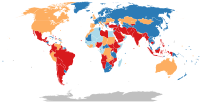
Photo from wikipedia
Introduction Secondary school closures aimed at limiting the number of infections and deaths due to COVID-19 may have amplified the negative sexual and reproductive health (SRH) and schooling outcomes of… Click to show full abstract
Introduction Secondary school closures aimed at limiting the number of infections and deaths due to COVID-19 may have amplified the negative sexual and reproductive health (SRH) and schooling outcomes of vulnerable adolescent girls. This study aimed to measure pandemic-related effects on adolescent pregnancy and school dropout among school-going girls in Kenya. Methods We report longitudinal findings of 910 girls in their last 2 years of secondary school. The study took place in 12 secondary day schools in rural western Kenya between 2018 and 2021. Using a causal-comparative design, we compared SRH and schooling outcomes among 403 girls who graduated after completion of their final school examinations in November 2019 pre-pandemic with 507 girls who experienced disrupted schooling due to COVID-19 and sat examinations in March 2021. Unadjusted and adjusted generalised linear mixed models were used to investigate the effect of COVID-19-related school closures and restrictions on all outcomes of interest and on incident pregnancy. Results At study initiation, the mean age of participants was 17.2 (IQR: 16.4–17.9) for girls in the pre-COVID-19 cohort and 17.5 (IQR: 16.5–18.4) for girls in the COVID-19 cohort. Girls experiencing COVID-19 containment measures had twice the risk of falling pregnant prior to completing secondary school after adjustment for age, household wealth and orphanhood status (adjusted risk ratio (aRR)=2.11; 95% CI:1.13 to 3.95, p=0.019); three times the risk of school dropout (aRR=3.03; 95% CI: 1.55 to 5.95, p=0.001) and 3.4 times the risk of school transfer prior to examinations (aRR=3.39; 95% CI: 1.70 to 6.77, p=0.001) relative to pre-COVID-19 learners. Girls in the COVID-19 cohort were more likely to be sexually active (aRR=1.28; 95% CI: 1.09 to 1.51, p=0.002) and less likely to report their first sex as desired (aRR=0.49; 95% CI: 0.37 to 0.65, p<0.001). These girls reported increased hours of non-school-related work (3.32 hours per day vs 2.63 hours per day in the pre-COVID-19 cohort, aRR=1.92; 95% CI: 1.92 to 2.99, p=0.004). In the COVID-19 cohort, 80.5% reported worsening household economic status and COVID-19-related stress was common. Conclusion The COVID-19 pandemic deleteriously affected the SRH of girls and amplified school transfer and dropout. Appropriate programmes and interventions that help buffer the effects of population-level emergencies on school-going adolescents are warranted. Trial registration number NCT03051789.
Journal Title: BMJ Global Health
Year Published: 2022
Link to full text (if available)
Share on Social Media: Sign Up to like & get
recommendations!